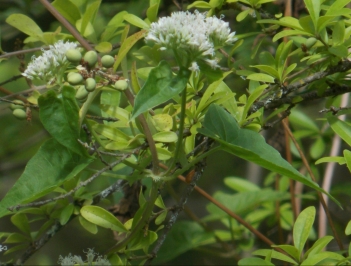Treebine; Cissus incisa Desmoul;. This soft stemmed, vine like, readily branching, deciduous plant that is a member of the grape family, Vitis, zig-zags between leaf nodes. Three lobed, crisp, almost succulent leaves, with coarse, pointed teeth and drip tips on each lobe, bud from each node, alternating sides, a climbing tendril grows opposite each leaf. Umbels of tiny green flowers which, like grapes, lack petals, bud from the ends of new growth, converting to loose bunches of black, juicy berries that look like grapes, but generally are not eaten. Treebine grows abundantly in well watered areas, though its tuberous root stores water, making it drought tolerant. It is usually found clamoring over other plants, but is often out of sight, as it readily climbs into the crowns of surrounding trees in search of light. (709) 6/10/17; 5/18/18; 19 no obs; 20 no obs;

Treebine habit; a woody, but soft vine-like plant that zig-zags between nodes, bearing coarsely toothed trifoliate leaves and umbels of tiny flowers that convert to juicy, black berries.

Note; crisp, succulent trifoliate leaves with coarse, pointed teeth on each leaflet, alternating along the soft stems, climbing tendrils growing opposite leaves at each node

Note; umbels of tiny greenish flowers lacking petals bud from the ends of new growth

Note; loose bunches of black, juicy, grape-like drupes, generally inedible, but not poisonous






























